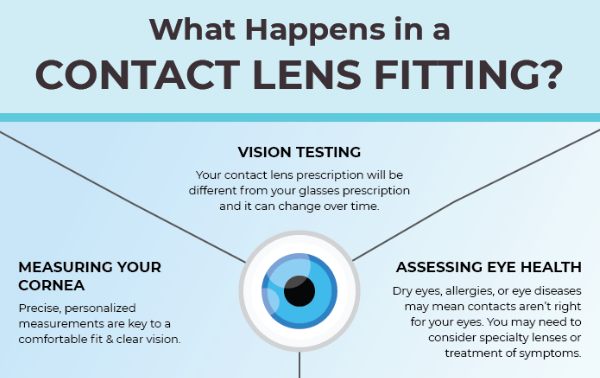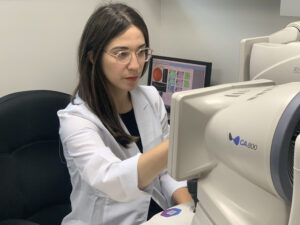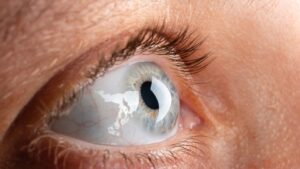To comprehend the significance of the scleral lens fitting process, it’s essential to first understand keratoconus and the role of scleral lenses in its treatment.
What is Keratoconus?
Keratoconus is a progressive eye condition that affects the shape and structure of the cornea. The cornea gradually thins and bulges into a cone-like shape, resulting in distorted vision. Common symptoms of keratoconus include blurred vision, increased sensitivity to light, and difficulty wearing traditional contact lenses.
Introduction to Scleral Lenses
Scleral lenses are specialized hard contact lenses designed to provide vision correction and comfort for individuals with various corneal conditions, including keratoconus. Unlike regular contact lenses that rest on the cornea, scleral lenses vault over the cornea and rest on the sclera (white part of the eye). These lenses create a tear-filled space between the cornea and the lens, improving vision by providing a smooth and regular optical surface.
Scleral lenses are custom-made to fit each individual’s unique eye shape, ensuring a comfortable and secure fit. Their larger diameter allows for enhanced stability and reduces the risk of lens dislodgement. Additionally, the tear layer between the lens and the cornea provides moisturization, making scleral lenses an excellent option for individuals with dry eyes.
Why Scleral Lenses are Used for Keratoconus
Scleral lenses are particularly well-suited for individuals with keratoconus due to their ability to address the irregular corneal shape and provide visual clarity. The unique design of scleral lenses helps to normalize the corneal surface, reducing the distortion caused by the cone-shaped cornea. By vaulting over the cornea, these lenses create a smooth optical surface, allowing light to properly focus on the retina, resulting in improved vision.
Moreover, the tear reservoir created by the space between the lens and the cornea acts as a protective barrier, providing comfort and reducing the friction that can occur with traditional contact lenses. This makes scleral lenses an ideal option for individuals with keratoconus who have experienced discomfort or challenges with other types of contact lenses.
Understanding the fundamentals of keratoconus and the unique benefits of scleral lenses helps to emphasize the importance of the subsequent steps in the scleral lens fitting process. By tailoring the lens to each individual’s specific needs, optometrists can optimize vision correction and ensure the utmost comfort for patients with keratoconus. To learn more about the benefits of scleral lenses, take a look at our article on Multiofocal Contact Lenses.
The Importance of a Proper Fit
When it comes to scleral lenses, a proper fit is of utmost importance. The fitting process plays a crucial role in ensuring optimal vision, comfort, and eye health for individuals with keratoconus. Let’s explore the role of scleral lens fitting, the benefits of a perfect fit, and the risks associated with an ill-fitting lens.

The Role of Scleral Lens Fitting
Scleral lens fitting is a specialized process that involves customizing the lenses to suit the unique needs of each individual. The fitting process is typically conducted by an eye care professional who specializes in contact lens fitting for keratoconus patients. During the fitting, several factors are taken into consideration, such as corneal topography, tear film evaluation, lens diameter, vaulting, and lens material. These factors help determine the right fit for the patient’s eyes, ensuring optimal vision correction and comfort.
Benefits of a Perfect Fit
A perfect fit with scleral lenses offers several benefits for individuals with keratoconus. These include:
- Improved Visual Acuity: Scleral lenses provide excellent visual acuity by effectively correcting the irregular shape of the cornea caused by keratoconus. The lenses create a smooth and even refractive surface, allowing light to focus properly on the retina.
- Enhanced Comfort: Scleral lenses, with their larger diameter and unique design, vault over the cornea and rest on the sclera. This creates a tear-filled reservoir between the lens and the cornea, providing comfort and preventing dryness. Some individuals who couldn’t tolerate traditional contact lenses find scleral lenses to be a more comfortable option.
- Increased Stability: The proper fit of scleral lenses ensures stability on the eye, reducing lens movement and the risk of dislodgement. This stability is especially important for individuals with active lifestyles or those who engage in sports.
- Protection and Lubrication: The tear reservoir created by the lens helps to protect the cornea from external irritants and provides a continuous supply of lubrication, alleviating symptoms of dryness and irritation.
Risks of an ill-Fitting Lens
Using ill-fitting scleral lenses can pose risks to eye health and comfort. Some potential risks include:
- Discomfort: If the lens does not fit properly, it can cause discomfort, such as irritation, redness, or a foreign body sensation. Discomfort can significantly impact daily activities and overall quality of life.
- Corneal Complications: An ill-fitting lens can exert excessive pressure on the cornea, leading to corneal abrasions, ulcers, or infections. These complications can be painful and may require medical intervention to prevent further damage.
- Suboptimal Vision Correction: If the lens doesn’t fit properly, it may not provide the desired level of visual acuity. This can affect daily tasks such as reading, driving, or working on a computer.
To avoid these risks, it is essential to undergo a thorough scleral lens fitting process and have regular follow-up visits with your eye care professional. They will assess the fit and make any necessary adjustments to ensure the lenses continue to provide optimal vision correction and comfort.
Proper fit is key to maximizing the benefits of scleral lenses and minimizing the risks associated with an ill-fitting lens. By working closely with your eye care professional and following their guidance, you can experience the advantages of scleral lenses for managing keratoconus.
The Scleral Lens Fitting Process – 4 Steps
When it comes to fitting scleral lenses for keratoconus, a comprehensive and detailed process is followed to ensure the best possible fit and vision correction. This process involves several steps, including an initial consultation, measurements and assessments, trial lens fitting, and follow-up visits and adjustments.
1. Initial Consultation and Evaluation
The first step in the scleral lens fitting process is the initial consultation and evaluation. During this appointment, your eye care professional will gather important information about your eyes, including your medical history and specific needs. They will also perform a thorough examination of your eyes to assess the severity of your keratoconus and determine if scleral lenses are the right option for you.
2. Measurements and Assessments
After the initial consultation, your eye care professional will proceed with a series of measurements and assessments. These evaluations will help determine the size and shape of your eyes, which is crucial for achieving a proper fit with scleral lenses. Measurements may include corneal topography, which provides detailed information about the curvature of your cornea, as well as tear film evaluation to assess the quality and quantity of tears.
3. Trial Lens Fitting
Once the necessary measurements and assessments are completed, your eye care professional will proceed with a trial lens fitting. During this step, a diagnostic or trial pair of scleral lenses will be placed on your eyes to evaluate the fit, comfort, and vision correction they provide. This trial period allows both you and your eye care professional to assess how well the lenses work for your specific needs.
4. Follow-up Visits and Adjustments
Following the trial lens fitting, regular follow-up visits will be scheduled to monitor your progress and make any necessary adjustments. These visits are crucial to ensure that the scleral lenses continue to provide optimal vision correction and comfort. Your eye care professional may make modifications to the lens parameters based on your feedback and any changes in your eyes.
The scleral lens fitting process is highly individualized and may require multiple visits to achieve the best possible fit and visual outcome. It is important to maintain open communication with your eye care professional throughout this process, as they rely on your feedback and experience to make the necessary adjustments. For more information on the benefits of scleral lenses for keratoconus, visit our article on scleral lenses for keratoconus.
By following the proper scleral lens fitting process, you can experience improved vision and enhanced comfort, allowing you to embrace daily activities with confidence. Regular follow-up appointments and proper lens care and maintenance are vital for long-term success with scleral lenses. Remember to consult with your eye care professional for personalized guidance and recommendations tailored to your specific needs.

Factors Considered in Scleral Lens Fitting
To ensure a successful and comfortable fit, several important factors are taken into consideration during the scleral lens fitting process. These factors include corneal topography, tear film evaluation, lens diameter and vaulting, and lens material and design.
1. Corneal Topography
Corneal topography plays a crucial role in determining the shape and curvature of the cornea. By using advanced imaging technology, such as corneal topography mapping, eye care professionals can create a detailed map of the cornea’s surface. This information helps in selecting the appropriate lens design and ensures a proper fit over the irregularly shaped cornea caused by keratoconus. The corneal topography data provides valuable insights into the specific lens parameters needed to optimize vision and comfort.
2. Tear Film Evaluation
A healthy tear film is essential for maintaining ocular health and ensuring comfortable lens wear. Tear film evaluation involves assessing the quantity and quality of tears produced by the eyes. This evaluation helps determine if the patient has any underlying dry eye conditions that may affect lens wear. If necessary, additional treatments or modifications can be recommended to improve tear film stability and reduce dryness or discomfort associated with lens wear. Learn more about the benefits of scleral lenses for dry eyes in our article on scleral lenses for dry eyes.
3. Lens Diameter and Vaulting
The diameter and vaulting of the scleral lens are critical factors in achieving a proper fit. The diameter of the lens should be carefully selected to ensure that it adequately covers the cornea and sclera without causing discomfort or compromising vision. The vaulting refers to the space between the back surface of the lens and the cornea. It is important to achieve an appropriate vaulting to prevent any potential corneal touch or irritation. Both factors are tailored to the individual’s unique eye shape and size to optimize comfort and visual acuity.
4. Lens Material and Design
The choice of lens material and design is another crucial consideration in scleral lens fitting. The lens material should be highly oxygen-permeable to promote corneal health and prevent complications associated with reduced oxygen supply. Additionally, the lens design should be customized to address the specific needs of the patient, taking into account the severity of keratoconus, tear film characteristics, and visual requirements. Eye care professionals may recommend specific lens designs, such as toric scleral lenses for astigmatism correction. For further information on this topic, refer to our article on scleral lenses for astigmatism.
By considering these factors during the scleral lens fitting process, eye care professionals can tailor the lenses to meet the unique needs of each patient. This personalized approach ensures a comfortable fit and optimal visual outcomes for individuals with keratoconus. Regular follow-up appointments are essential to monitor the fit and make any necessary adjustments to maintain the best possible vision and comfort. For more information on the benefits of scleral lenses, check out our article on the benefits of scleral lenses.
Ensuring Success with Scleral Lenses
To ensure a successful experience with scleral lenses, it is essential to follow proper care and maintenance practices, attend regular follow-up appointments, and maintain open communication with your eye care professional.
Proper Lens Care and Maintenance
Proper care and maintenance of your scleral lenses are crucial for maintaining their hygiene and maximizing their lifespan. Here are some important tips to keep in mind:
- Cleanliness: Wash your hands thoroughly with soap and water before handling your lenses. Use a recommended lens cleaning solution to clean and disinfect your lenses daily. Avoid using tap water or saliva, as they may contain harmful microorganisms that can lead to eye infections.
- Storage: Store your scleral lenses in a clean lens case filled with fresh disinfecting solution. Replace the solution daily and rinse the case with a sterile solution, allowing it to air dry.
- Rinsing: Before inserting your lenses, rinse them with a sterile saline solution to remove any debris or residue. This helps ensure clear vision and prevents discomfort.
- Avoiding Irritants: Steer clear of products that can damage or contaminate your lenses, such as oil-based cosmetics, aerosol sprays, and harsh chemicals. When applying makeup, choose oil-free and fragrance-free options. If you experience dry eyes, consult your eye care professional about scleral lenses for dry eyes to address this issue.
- Replacement Schedule: Follow the recommended replacement schedule for your lenses. Over time, the material of the lenses may deteriorate, affecting their fit and performance. Regularly replacing your lenses helps maintain optimal vision and comfort.
Regular Follow-up Appointments
Regular follow-up appointments with your eye care professional are essential for monitoring the fit and condition of your scleral lenses. During these visits, your eye care professional which is certified Michigan eye specialist will evaluate the fit of your lenses, assess your comfort level, and address any concerns you may have. They may make necessary adjustments to ensure the lenses are providing the best possible vision and comfort for your specific needs.
Attending these appointments as scheduled allows your eye care professional to detect any changes in your eye health or lens fit early on, preventing potential complications. Regular check-ups also provide an opportunity to discuss any issues or difficulties you may be experiencing and explore possible solutions.
Communication with Your Eye Care Professional
Maintaining open communication with your eye care professional is crucial throughout your scleral lens journey. If you experience any discomfort, vision changes, or other issues with your lenses, it’s important to communicate these concerns promptly. Your eye care professional can provide guidance, make necessary adjustments, or recommend alternative options if needed.
Additionally, if you are considering scleral lenses for specific conditions like astigmatism or keratoconus, discussing your specific needs with your eye care professional is vital. They can guide you in selecting the most suitable lens design and material for your individual requirements.
By following proper care and maintenance practices, attending regular follow-up appointments, and maintaining open communication with your eye care professional, you can ensure the success of your scleral lens experience. Remember, your eye care professional is your trusted partner in providing the best possible vision and comfort with scleral lenses.
Frequently Asked Questions (FAQs):
Are scleral lenses only for keratoconus?
While scleral lenses are commonly used for keratoconus, they can also benefit individuals with other corneal conditions and irregularities. Consult with your eye care professional to determine if scleral lenses are suitable for your specific needs.
How often should I have follow-up appointments for my scleral lenses?
Follow-up appointments are typically scheduled based on your eye care professional’s recommendations. Regular visits, especially in the initial stages, are crucial to monitor lens fit, address any issues, and ensure optimal vision and comfort.
Can I swim or shower with scleral lenses?
A: It is generally advised to avoid exposing scleral lenses to water, including swimming or showering, to prevent contamination and reduce the risk of infection. Consult with your eye care professional for specific guidance on lens care in various situations.
How do scleral lenses differ from traditional contact lenses?
A: Scleral lenses vault over the cornea and rest on the sclera, creating a tear-filled space that improves vision and comfort. This design differs from traditional contact lenses that rest directly on the cornea. Scleral lenses are often preferred for irregular corneal conditions.
Can I sleep with scleral lenses?
In general, it is not recommended to sleep with scleral lenses. Removing and properly cleaning the lenses nightly is essential for maintaining eye health and maximizing the lifespan of the lenses
Wrapping Up
In summary, scleral lenses are instrumental in treating keratoconus, providing a unique solution to the progressive corneal condition. Their specialized design, custom fitting process, and larger diameter offer improved visual acuity, enhanced comfort, and stability, making them particularly effective for individuals facing challenges with traditional contact lenses.
The fitting process involves a meticulous assessment, considering factors like corneal topography and tear film evaluation. A perfect fit ensures optimal vision correction and comfort, while regular follow-up visits, proper care, and open communication with eye care professionals are crucial for a successful and comfortable experience with scleral lenses, ultimately improving the quality of life for those with keratoconus.























